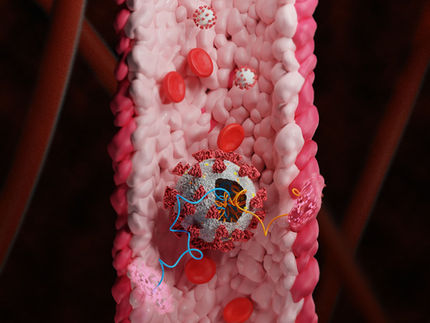New blood-clotting inhibitor that can be switched off by irradiation
Built-in BlockerDrug and antidote in the same molecule
Advertisement
In cases of serious side effects or overdoses of medications, it can be vital to have a fast-acting antidote on hand. This is especially true of drugs that inhibit blood clotting, which are used to prevent and treat thromboses and embolisms, to treat heart attacks, and, in higher doses, in dialysis and in heart surgeries involving a heart-lung machine. Overdoses can lead to life-threatening hemorrhages.
Unfractionated heparin is so far the only blood-clotting inhibitor for which a specific antidote exists. This classic thus continues to be the fallback agent for patients with a high risk of bleeding and in applications requiring rapid reversal of the anticoagulating effect,even though a number of newly developed blood-clotting inhibitors would be more advantageous with regard to their other characteristics.
A research team led by Alexander Heckel, Günter Mayer, and Bernd Pötzsch in Bonn, Germany, has now developed an anticoagulant that brings along its own antidote. Irradiation with UV light activates the part of the molecule that acts as the antidote, which almost immediately halts the blood-clotting inhibition.
This new substance is based on an aptamer that binds to thrombin, a key protein in blood clotting, and blocks it. Aptamers are short, single strands of nucleic acid (DNA) that can bind to another molecule - thrombin in this case - with strength and specificity similar to those of an antibody. In doing this, the aptamer folds into a three-dimensional structure that is perfectly tailored to the structure of the target molecule. The researchers bound another short DNA strand to the thrombin-binding aptamers. This fragment can act as antidote as soon as its "starter" is activated. As long as the antidote hasn't been activated, the new drug is a highly effective anticoagulant.
If the aptamer's blood-clotting inhibition needs to be switched off, the drug is irradiated with UV light to activate the starter. The short antidote DNA strand is complementary (the counterpart) to a segment of the thrombin-binding aptamer strand-except for a special, slightly altered nucleotide that acts like an error in the sequence. DNA fragments that are complementary to each other have the tendency to stick together to form a double strand; however, this is initially inhibited by the altered nucleotide. UV light causes a part of this altered nucleotide to split off, thus making it a normal nucleotide. The sequence error is removed and thus the counterpart can bind tightly to the aptamer strand, forcing the drug into a hairpin-like form. The previous three-dimensional structure of the aptamer is disrupted - and so is its bond to thrombin as well as its anticoagulating effect.
Original publication: Alexander Heckel et al.; "An Anticoagulant with Light-Triggered AntidoteActivity"; Angewandte Chemie International Edition 2006,45, No. 40, 6748-6750.


















































